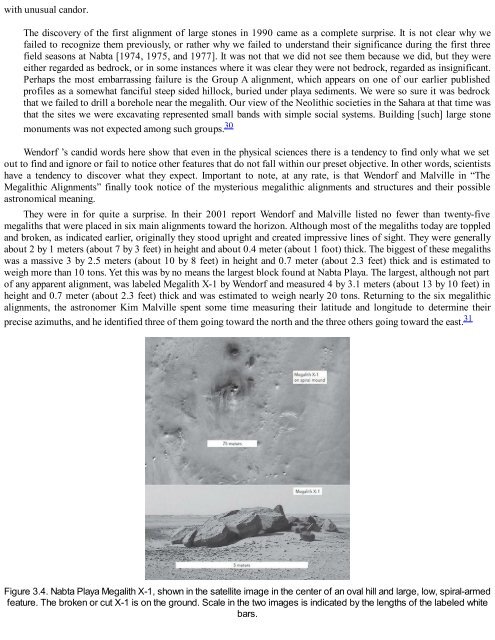Black Genesis: The Prehistoric Origins of Ancient Egypt
Black Genesis: The Prehistoric Origins of Ancient Egypt
Black Genesis: The Prehistoric Origins of Ancient Egypt
You also want an ePaper? Increase the reach of your titles
YUMPU automatically turns print PDFs into web optimized ePapers that Google loves.
with unusual candor.<br />
<strong>The</strong> discovery <strong>of</strong> the first alignment <strong>of</strong> large stones in 1990 came as a complete surprise. It is not clear why we<br />
failed to recognize them previously, or rather why we failed to understand their significance during the first three<br />
field seasons at Nabta [1974, 1975, and 1977]. It was not that we did not see them because we did, but they were<br />
either regarded as bedrock, or in some instances where it was clear they were not bedrock, regarded as insignificant.<br />
Perhaps the most embarrassing failure is the Group A alignment, which appears on one <strong>of</strong> our earlier published<br />
pr<strong>of</strong>iles as a somewhat fanciful steep sided hillock, buried under playa sediments. We were so sure it was bedrock<br />
that we failed to drill a borehole near the megalith. Our view <strong>of</strong> the Neolithic societies in the Sahara at that time was<br />
that the sites we were excavating represented small bands with simple social systems. Building [such] large stone<br />
monuments was not expected among such groups. 30<br />
Wendorf ’s candid words here show that even in the physical sciences there is a tendency to find only what we set<br />
out to find and ignore or fail to notice other features that do not fall within our preset objective. In other words, scientists<br />
have a tendency to discover what they expect. Important to note, at any rate, is that Wendorf and Malville in “<strong>The</strong><br />
Megalithic Alignments” finally took notice <strong>of</strong> the mysterious megalithic alignments and structures and their possible<br />
astronomical meaning.<br />
<strong>The</strong>y were in for quite a surprise. In their 2001 report Wendorf and Malville listed no fewer than twenty-five<br />
megaliths that were placed in six main alignments toward the horizon. Although most <strong>of</strong> the megaliths today are toppled<br />
and broken, as indicated earlier, originally they stood upright and created impressive lines <strong>of</strong> sight. <strong>The</strong>y were generally<br />
about 2 by 1 meters (about 7 by 3 feet) in height and about 0.4 meter (about 1 foot) thick. <strong>The</strong> biggest <strong>of</strong> these megaliths<br />
was a massive 3 by 2.5 meters (about 10 by 8 feet) in height and 0.7 meter (about 2.3 feet) thick and is estimated to<br />
weigh more than 10 tons. Yet this was by no means the largest block found at Nabta Playa. <strong>The</strong> largest, although not part<br />
<strong>of</strong> any apparent alignment, was labeled Megalith X-1 by Wendorf and measured 4 by 3.1 meters (about 13 by 10 feet) in<br />
height and 0.7 meter (about 2.3 feet) thick and was estimated to weigh nearly 20 tons. Returning to the six megalithic<br />
alignments, the astronomer Kim Malville spent some time measuring their latitude and longitude to determine their<br />
precise azimuths, and he identified three <strong>of</strong> them going toward the north and the three others going toward the east. 31<br />
Figure 3.4. Nabta Playa Megalith X-1, shown in the satellite image in the center <strong>of</strong> an oval hill and large, low, spiral-armed<br />
feature. <strong>The</strong> broken or cut X-1 is on the ground. Scale in the two images is indicated by the lengths <strong>of</strong> the labeled white<br />
bars.


